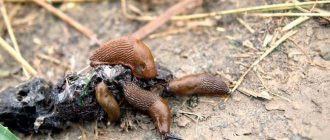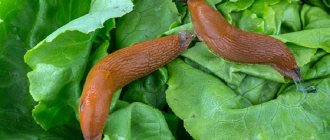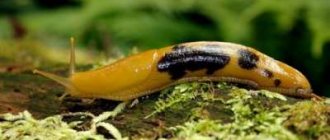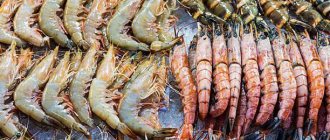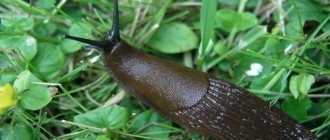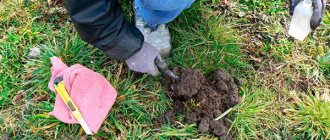What kind of slugs are there?
Slugs are gastropods, land mollusks.
There are several varieties of these pests:
- Slugs are oblong mollusks without a shell. Most often they have a grayish-yellow or earthy color. They are the ones who most often attack vegetable gardens and orchards.
- Half-slugs are recognized by their rudimentary shell.
- Snails are horned slugs with a shell. There are many varieties of snails: forest snail, variegated garden snail, common hairy snail, bush snail, and grape snail. They all differ in the color of the body and the shape and coloring of the shell.
Mollusks live for several years: snails - 3-4 years, slugs - 1-2 years. They become most active in the second half of summer. Parasites actively reproduce, laying eggs in dark and damp places. Most often, clutches, and even the slugs themselves, can be found under stones, old stumps, in compost, garbage and manure heaps, under old tree bark, etc.
Slugs and snails are mostly nocturnal and hide in secluded places during the day.
In what places do slugs lay larvae?
Mollusks begin to reproduce from October until the first frost. Typically, the pest lays larvae in cold and dark places with high humidity. Such secluded corners can be found under leaf litter and firewood, large stones, where compost has been added. Slug eggs can also be found at the roots of plants. Slugs can climb into outdoor planters to lay eggs. The eggs survive the winter without harm. The clams begin to hatch in early spring. Already in mid-summer, the young animals turn into adults. Under suitable conditions in the garden, hatching of mollusks will occur within a few weeks.
What harm do they do?
Slugs feed on plant leaves. Moreover, they give the greatest preference to cultivated plants. Using their mouthparts, they devour soft tissue and gnaw holes in leaves, leaving mucus.
IMPORTANT! Moving from plant to plant, mollusks not only eat plant tissue, but also spread infection.
Mollusks feed on seeds, flower corms, berries (they especially like strawberries), cabbage and other vegetables. They do not disdain flowers and fruits if they can get to them. This is not to mention the leaves and stems of plants mentioned above.
Helpful tools for pest control
Before using chemicals, you can try to reduce the slug population manually. Yes, it will take some time and require manual labor, but you can be sure that the soil does not contain harmful compounds that can penetrate into fruits and vegetables.
Advantages:
- Absolute safety.
- Destruction of a large number of slugs at once.
- Effective in small garden and summer cottage areas.
- Can be used on any type of soil.
Flaws:
- Ineffective over large areas of land.
- Requires manual labor.
It is easier to fight slugs, since they lack a protective shell and react more sharply to changes in the external environment. Snails are more protected, but they can also be dealt with if you work hard.
Watering and mulch
Since gastropods love moisture, they need to be deprived of these comfortable conditions. To do this, use drip point irrigation and mulching the surface of the earth around the plant.
Necessary:
- In the hole next to the seedling, place a plastic bottle cut to half, neck down.
- The top of the bottle should rise 3-5 cm above the soil surface.
- The ground around the seedling should be sprinkled with a thin layer of mustard powder, and a thick layer of mulch should be laid on top.
- Hay, grass, and straw are suitable as mulch.
- Watering should be done exclusively through a bottle. This way, moisture is delivered directly to the roots, and the root zone always remains dry.
- Mustard repels pests and also causes severe burns to the mollusk's body upon contact.
Since there is no constant watering from the surface of the earth, there is no need for hilling. This significantly reduces manual labor costs.
Manual collection
When there are a lot of snails on the site, their population is reduced by hand collection.
To do this you need:
- Take a piece of polyethylene or fabric and soak it in polyethylene.
- Place it near the plants most loved by slugs in the evening.
- In the morning (6-7 hours), lift the polyethylene and collect all the pests in a jar.
- You can destroy them by pouring a small amount of vinegar.
The procedure is carried out for 3 days in a row, after which they take a break for 1 day and repeat for another 3 days. This simple manipulation is enough once a month to get rid of slugs and snails without chemicals.
The most common traps
If there is no opportunity (and no desire) to tinker with small slugs, they prepare traps, the contents of which are destructive to pests and absolutely safe for plants and humans.
The most effective of them are:
- Trap made of corn flour and mustard powder - take a small pinch of crushed mustard for 1 tablespoon of flour. Place in a saucer with a low side or nylon lids. Place under the stems of cabbage, tomatoes, lettuce, and peppers. Cornmeal causes indigestion in the digestive system, which kills the slug.
- Salt and meat - take a plastic glass or bottle without a neck, bury it in the ground to its full depth so that the upper part is flush with the soil surface. Pour warm water in which 6 tablespoons of table salt are dissolved. A bottle cap is placed on the surface of the water, into which the bait is placed. It is best to take boiled or fried meat. Following the smell, the snails crawl towards the bait, after which they fall into a salty solution, which is destructive to their delicate body.
- Beer trap - several holes are made in a plastic bottle with a small amount of beer so that the drink drips slowly and attracts slugs. Early in the morning, the bottle will be surrounded by more than a dozen gastropods, which can be easily collected by hand and destroyed.
As additional protection for the beds, pollination is used with a mixture of wood ash and ground wormwood. To do this, you need to take 4 cups of ash and half a cup of dry ground wormwood herb. Sprinkle around the perimeter of the bed where there is no watering and the soil is dry.
Expert opinion Stefania Bogdanovna Mityuk
This mixture is extremely destructive for gastropods, which will help protect individual beds and bushes from invasions. This method is especially effective when growing cabbage.
Evening coffee
If there are too many snails and traps are ineffective, you can spray cabbage, pepper and tomato plants with weak coffee.
To do this, take 1 liter of warm water, add a few drops of detergent or liquid soap (for better adhesion) and dissolve 3 tablespoons of the cheapest coffee without sugar or additives. Spray the plant after evening watering in dry, windless weather.
The smell of coffee repels pests, and not just slugs and snails. And if you scatter the remains of brewed natural coffee under the bushes, the gastropods will leave the territory forever.
Why do slugs and snails appear in the garden?
As mentioned above, slugs and snails are an important part of the ecosystem. In search of food and favorable conditions for growth and reproduction, slugs migrate between areas. If yours suits them, then they stay on it.
What does it mean? Slugs love moisture and warmth , and they also need shelter from the sun. If your site is waterlogged, there are many shady damp areas, boards are scattered, and stumps have not been removed, then with a high degree of probability you will encounter an invasion of slugs in the second half of summer.
Read more: How to get rid of wireworms in potatoes and root vegetables at your summer cottage
Pests can also enter the garden along with infected vegetables, cuttings, seedlings, etc.
Who are slugs and where do they come from in the house?
Slugs belong to the class of gastropods. They are identical to snails, but do not have a house on their back. On their head there are 4 processes, very similar to small horns.
During the daytime, slugs hibernate, and at nightfall they come out of their hiding places in search of food. They gnaw fruits, vegetable roots, as well as leaves and shoots of various plants.
The body of these mollusks is imperfect; they often suffer from dehydration. To avoid such an undesirable condition, they make their way into the bathroom, into dark basements and cellars, where the temperature is about +15 degrees and there is a high level of air humidity. There it is easier for their body to maintain water-salt balance.
Representatives of this class are hermaphrodites, that is, each individual is endowed with both male and female reproductive organs. When 2 slugs meet, they fertilize each other, and soon eggs are laid in the soil. A slug lays from 11 to 34 eggs at a time.
Less than a month passes after the eggs are laid, and young slugs are born from them. Having fed, young slugs become adults after 45 days; they are able to mate and lay eggs.
How to get rid of slugs using traditional methods
Unlike most insect pests, which are often only controlled by chemical insecticides, slugs can be controlled using traditional methods. The point here is that gastropods move only on the ground. Therefore, there are many ways to protect plants from them using simple traps and unique “barricades”.
REFERENCE. Most traditional methods take advantage of the main weakness of slugs - their soft and very sensitive body, which easily gets burned from contact even with not the strongest reagent.
How to use slaked lime
When shellfish invade your area, protect your plantings with slaked lime traps. Dilute it in water and pour a small stream into the improvised channels around the perimeter of the beds. This should be done after sunset, when the slugs become active. The mollusk crawls onto this “path” of lime and gets a chemical burn.
Pepper infusion against slugs
Use dried chilies or just buy ground pepper from the store. Pour 50 grams of the substance into a liter of cold water, leave for 2 days, then boil and leave again for two days. The resulting working solution is sprayed onto the plants before flowering.
Mustard powder for slugs
An infusion is made from mustard powder, which is sprayed on plants and watered on the ground around them. Mix 200 ml of water with a spoon of mustard, leave for an hour and add to 10 liters of water.
How to make bait traps
The next method is making bait traps. Place grated carrots, a piece of beetroot or leaves on the ground in a shady place. Cover the top with a rotten board or similar covering.
Periodically collect and destroy shellfish that have accumulated on your trap.
Wormwood infusion
This recipe will help not to destroy slugs, but to scare them away from plants . The fact is that mollusks cannot stand the smell of wormwood.
The tincture is prepared as follows.
Pick the wormwood and chop it finely with a knife. Then add water at the rate of 1 part wormwood to 5 parts water. Leave the mixture to ferment, stirring every day. In a month the infusion will be ready. Spray plants with it to protect against slugs .
IMPORTANT! Since the product is infused for 4 weeks, take care to prepare it in advance.
Catching slugs by hand
If there are not very many pests, then it makes sense to collect them manually. And then either destroy it or take it off site. But remember that it is better to wear gloves when collecting shellfish, as they leave sticky mucus on your hands.
Mulch for pests
Mulch as a remedy for slugs has been known since the 60s of the last century. Mulch plantings and row spacing, and then mollusks will not be able to get to your plants. Remember, the less smooth the surface, the harder it will be for slugs.
Does beer help with slugs?
You can fight shellfish using beer traps. You will need several half-liter plastic cups or plastic bottles cut in half and beer. Containers are dug in around the perimeter of the beds or some individual vegetables. You can bury the cups flush with the ground or just above the soil level. Then beer is poured into the container. The smell and taste of the drink attracts slugs. They crawl into glasses and drown in them.
Read more: Description and fight against the click beetle (wireworm) on potatoes
How to use baking soda
Baking soda can be used in two ways. The first is to sprinkle it on the pests in the discovered lair. This will cause instant death of the entire population. You can also prepare a solution for spraying: 5 liters of water, 50 grams of soda, 10 ml of liquid soap or shower gel.
Vinegar as a means of control
Vinegar is used in the same way. 65 ml of 9% vinegar is diluted in 10 liters of water and sprayed with a solution of slugs.
Are they afraid of ammonia?
Ammonia helps in the fight against harmful shellfish. 2 tablespoons of liquid are diluted in 5 liters of water and the plants are sprayed. The smell of ammonia is unbearable for gastropods, and they do not attack plants.
Who are slugs and where do they come from?
Questions about what slugs are, where they come from in cellars, and whether it is difficult to get rid of them if they have already settled in the basement or basement are of interest to many owners of houses and cottages. According to the biological classification, the slug is a land gastropod that does not have a shell. Most common in middle climate zones. The habitat consists of territories with an average temperature of +15...+19°C from spring to autumn.
The slug has an elongated body, slightly flattened on top. In the front part there are tentacles that can retract and extend. At their tips there are several types of receptors: optical, olfactory and gustatory. The mouth is also located on the front of the head. It is equipped with a jaw with a sharp chitinous edge. Using its jaw and tongue, which has sharp teeth like a grater, the slug bites and grinds food.
Behind the head is the mantle, which is a denser part of the slug's body. This padded collar protects the lungs. On the right side of the mantle there is a respiratory opening, which is clearly visible in large individuals. The anus is also located nearby. Behind the mantle, the longest part of the body is the leg, with which the mollusk moves.
What medications are there for slugs and snails, table
Special chemical preparations for slugs are called molluscicides. You can find out which of them are most effective in the fight against gastropods from the table below.
| Means | Method of preparation and use |
| Mesurol | Scatter the granules over the beds of plants most affected by slugs. Keep away from children and animals. Work strictly with gloves |
| Nemaslug | Spray the plants and water the soil around them. Treat 2-3 times at intervals of 1-2 weeks |
| Unichem | The gel is applied around plants (effective for large bushes) or along the perimeter of the beds. Creates a coating that slugs cannot overcome |
| BROS | Spread the granules over the entire area at the rate of 80 grams per 10 sq. m. Use in the afternoon. Take care of plants |
| Groza-3 | Sprinkle the powder on the area at the rate of 30 grams per 10 square meters in places where shellfish accumulate or appear most frequently. |
| Slug eater | Sprinkle the powder on the site at the rate of 30 grams per 10 square meters in places where shellfish accumulate or appear most frequently, as well as along the beds and between the rows. |
| StopUlit | Place baits in front of the plants. Apply as needed |
| NEUDORFF Ferramol | 500 grams per hundred square meters. Sprinkle later in the evening. Apply no more than 4 times per season |
| Predator | Place the bait on the substrate. 1 package per 70 sq. m., at least 4 traps per 10 sq. m. |
| Ulicide | 500 grams per hundred square meters. Sprinkle later in the evening. Apply once per season |
| Meta | Sprinkle the powder on the site in places where shellfish accumulate or appear most frequently, as well as along the beds and between the rows. |
Fighting slugs in the basement
Radical methods of getting rid of gastropods include a sulfur smoke bomb. It is guaranteed to kill not only the gastropods themselves, but also their larvae. Pest control in the cellar using a checker is also a preventive measure. It is important to strictly follow the instructions:
- Remove all food items from the premises, even if they are stored packaged.
- Carefully seal all holes to prevent smoke from escaping.
- Wet all surfaces generously with water. Important: metal objects must be removed. If this is not possible, they must be treated with grease or painted to prevent corrosion. Sulfur smoke, reacting with moisture, forms an acid that is very harmful to metal.
- Wear gloves, mask, goggles.
- Place sulfur bombs inside the cellar. The quantity depends on the area of the room, 6-8 square meters. m. you will need 4 pieces. Important: checkers must be placed on a fire-resistant surface. Often special stands are sold as a set.
- Light the wick using soft paper. Please note: the optimal indoor air temperature is 0 degrees. The warmer it is, the worse the sulfur will be better absorbed by the surface.
- Close the exit tightly. Smoldering lasts 0.5-1.5 hours. Do not open the basement for three days. Important: it is prohibited to use a saber in residential multi-storey buildings, because the volatile properties of the smoke are high. He is able to climb several floors. You must leave your private home during processing.
- Open all windows, doors, ventilate the cellar for a day.
- Collect dead pests and carry out wet cleaning.
- How to remove wrinkles under the eyes quickly and effectively
- Separate meals for weight loss: menu and food table
- Meatballs in the oven with gravy: recipes
For preventive purposes, it is recommended to carry out the following measures that will get rid of not only slugs, but also other parasites:
- periodic cleaning of the basement;
- regular drying and ventilation;
- Before placing food in the basement, you need to dry it well;
- calcareous pollination;
- treat surfaces with copper sulfate solution.
Plants that repel pests
In order not to have to worry about preparing preparations for slugs and not to set traps, you can plant plants around the area whose smell repels pests.
These include onions and garlic, mustard, marjoram, wormwood, thyme, savory and some others. Plan the planting of these plants so that slugs do not have access to vegetable and berry crops.
Thyme
Mechanical methods of struggle
Mechanical methods of combating slugs and snails mean creating protective barriers that are insurmountable for mollusks.
You can block the path of slugs to your vegetables and berries by sprinkling the paths with a mixture of sawdust with ash, bark, and pine litter. Egg shells, coarse sand, etc. are also effective.
Read more: How to get rid of aphids on trees using traditional methods forever?
You can also bury coffee grounds under plants. The result will be both a death trap for shellfish and a nutritious food for plants.
Another rather expensive way to protect yourself from invasion is to lay covering material with a copper coating around the perimeter of the plot or beds, which generates a low-voltage current. However, even weak electricity causes significant damage to the mollusks, and they begin to avoid the area.
Chemical methods
If the gastropod population is too large and other methods do not work, chemicals are used. Shellfish are sensitive to metaldehyde. Several drugs have been developed based on it. The most commonly used is “Slug Eater”, which comes in the form of powder and small granules. The smell of the product attracts shellfish. After eating it for a short time, the pests die.
The product can be used on vegetables, fruits, citrus fruits, berries, flower and ornamental crops and grapes. The period of protective action of the drug is 14 days.
Buy "Slug Eater" with delivery
Medicine for slugs and snails AVGUST Slime Eater Neo, 56g. It is highly effective and has a long-lasting protective effect. Helps to avoid a decrease in yield.
Buy a remedy for slugs and snails
Lime traps
To kill snails (slugs), sprinkle the surface of the soil with freshly slaked lime powder. Sprinkling the soil with lime is carried out in 2 steps within an interval of 10-15 minutes. During the first sprinkling, the snail protects itself from lime by secreting mucus, but with the second sprinkling, the snail is no longer able to secrete mucus, turns black and dies. By sprinkling the soil with lime in this way for two days in a row, in the morning, you can completely destroy all the snails.
Protects against garden pests. Suitable for neutralizing soil acidity, protecting tree trunks from burns.
Buy lime with delivery
Prevention measures
As we said above, with rare exceptions, slugs do not attack well-groomed areas. The most important measure to prevent the appearance of these pests is to keep your garden, garden or summer cottage clean and tidy.
- Remove weeds, even if they are located at the edge of your garden.
- Loosen the soil more often. Try to ensure that it has a uniform structure.
- Attract birds to your garden. But not too hard, otherwise you’ll have to drive away the birds later.
- Maintain order in the area. Do not create piles of rotten boards, remove stumps, stones, etc.
- Digging up the soil in the fall, as mollusks hide in it for the winter.
- Do not allow your area to become over-watered.
Preventing slugs
Please note that limiting the spread of slugs is a labor-intensive process that must be carried out every year. There are many preventative measures, the regular implementation of which will help limit the spread of the Spanish slug - this includes regular mowing of roadsides, ditches, and grassy areas near slug habitats.
It is advisable to remove the mown grass so that slugs do not have the opportunity to hide. Given that slugs are also attracted to compost, it is recommended to use closed compost bins that do not allow slugs to enter or move around.
Common mistakes
Fighting slugs is a tedious and thankless task. Let's consider where and what mistakes gardeners make in this struggle.
- Ignoring the problem. Snails and slugs are often not taken seriously. Although they can cause no less problems than aphids or May and Colorado potato beetles. Therefore, it is very important to start fighting slugs as soon as you see the first individuals in your area.
- Slug-killing techniques are being used, although the area is a mess. The most important thing that a summer resident must do is to create conditions in which slugs cannot live and reproduce. The destruction of individual individuals is only a small part of the process of combating mollusks.
- Treatment with strong-smelling products during flowering. This scares away bees that fly away from the area.
- Inaccurate use of molluscicides. Firstly, the granules must not fall on the leaves and stems of plants. Secondly, when using chemical poison, be sure that children and animals will not reach it.
Brief descriptions of common slug species
The common naked slug has a yellow-white or gray-pink smooth body. Its size can reach 6 cm. Its habitats are forests and summer cottages. Vegetable beds suffer the most from it.
The netted field slug has a wrinkled body that is yellow-white or brown in color. On its back and mantle there are many black streaks and spots of the same color. The length of an adult parasite is 5-6 cm.
It is not as harmful as the common slug, but it also prefers to feed in vegetable beds.
The naked slug brown arion has a body covered with dense skin. There are 24 rows of small wrinkles on each side. The color is reddish or yellow-orange, and the back is brown.
On the side there are two dark stripes with blurred contours. The length can reach 7 cm. This species is widespread in both northern and southern latitudes.
Answers to frequently asked questions
Is it necessary to control slugs on the site?
Yes, because otherwise they will multiply and cause irreparable damage to the harvest
Which product is most effective in fighting slugs?
The most effective way is to create unbearable living conditions for them. Otherwise, use molluscicides and slaked lime traps.
There are a lot of slugs in cabbage, what should I do?
Treat the plants with molluscicides (don't forget to add soap for sticking), and place traps around them.
How to prevent shellfish from appearing on your property?
Remove household and construction waste. Avoid accumulation of leaves, old branches, carrion, rot and stumps. Keeping the area clean is the key to pest-free areas. Also plant plants around the perimeter of the site whose smell is unbearable for shellfish.
Chemical repellents for slugs
The use of chemical protection is recommended in extreme cases when other types of protection have failed. To protect against slugs, the following drugs are used:
| Name | Consumption per sq. m. | Validity period, days. | Frequency of treatments |
| Storm | 3 g | 14 – 21 | 1-2 per season |
| Slug eater | 3 g | 14 | 1 per season |
| Bros | 0.8 g | 90 | 1 per season |
| Metaldehyde | 0.4 g | 20 | 1-2 per season |
| Ulicide | 3-5 g | 14 – 21 | 1 per season |
All preparations are produced in the form of granules, which are laid out along the perimeter of the ridge and between the plants. It is recommended to use the drug 20 days before harvesting. The drugs are dangerous for pets. Their effect lasts for two weeks after rains. However, in wet weather the drugs become much less effective.
